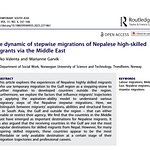Related Country/Destination Global
Theme Developing Diaspora Engagement
Related Country/Place of Origin Nepal
Author IOM Nepal
Language of Resource English
20 November 2024Introduction
The Diaspora Mapping and Engagement in Nepal report, published by IOM Nepal in collaboration with the Non-Resident Nepali Association (NRNA) and the Government of Nepal’s Ministry of Foreign Affairs, provides a detailed analysis of the Nepalese diaspora’s role in national development. Supported by Swiss Development Cooperation, the study maps the socioeconomic profiles, migration trends, financial contributions, and engagement patterns of Nepalis living abroad.
With over 2.1 million Nepalese migrants worldwide, the diaspora significantly impacts Nepal’s economy, cultural landscape, and social development. Remittances alone account for 23.1% of Nepal’s GDP, making the diaspora a crucial driver of economic stability. However, bureaucratic hurdles, policy gaps, and a lack of structured engagement channels limit their contributions.
This report not only identifies key challenges and opportunities but also proposes a strategic roadmap to enhance diaspora engagement, investment policies, and knowledge-sharing initiatives.
Book Summary
The report explores the demographics, financial influence, and policy needs of Nepalese communities spread across 16 priority countries, including the United States, United Kingdom, Australia, Canada, Japan, UAE, and South Korea.
Key Areas Covered:
1. Demographic & Migration Trends
Majority male-dominated (82.2%), with limited participation from women (17.8%).
Young and skilled diaspora, with over 66% under 45 years old.
Migration is primarily driven by employment opportunities, education, and family reunification.
Japan, Qatar, and the UK see higher proportions of temporary migrants, while the US, Canada, and Australia have more permanent residents and citizens.
2. Economic Contributions: Remittances & Investment
Nepal ranks among the top 10 remittance-receiving countries globally, with $9.3 billion sent home in 2022.
While remittances help families cover essential needs, they are not effectively leveraged for long-term development projects.
Investment from NRNs is growing, but corruption, unstable regulations, and weak financial infrastructure deter many from larger-scale business ventures.
3. Knowledge & Skills Transfer
Nepal has launched the Brain Gain Centre, a program designed to attract diaspora professionals in science, business, and technology to share expertise.
However, low awareness and lack of structured programs have limited participation.
Diaspora members show strong interest in mentorship, education initiatives, and professional exchange programs.
4. Diaspora Philanthropy & Social Development
Nepali expatriates actively support humanitarian projects, such as disaster relief, education, and healthcare initiatives.
However, these contributions remain sporadic and unstructured. A centralized funding and impact-tracking mechanism could increase effectiveness.
5. Barriers to Engagement
Lack of dual citizenship prevents NRNs from investing more freely.
Complicated land ownership laws discourage investments in property or business.
Limited communication channels between Nepalese authorities and the diaspora make engagement fragmented and inefficient.
6. Policy Recommendations for Better Engagement
The report proposes a “Roadmap for Enhancing Nepalese Diaspora Engagement,” focusing on:
✅ Introducing diaspora-friendly investment policies (simplified business registration, tax incentives).
✅ Expanding voting rights for NRNs to strengthen their political representation.
✅ Creating digital engagement platforms for better government-diaspora collaboration.
✅ Reforming property and investment laws to make NRN investments easier and more secure.
✅ Strengthening educational and cultural exchange programs to preserve Nepali heritage abroad.
Key Takeaways
1. The Nepalese Diaspora is a Major Economic Force
Remittances boost Nepal’s economy, but better investment policies are needed to channel funds into long-term growth projects rather than short-term family expenses.
2. NRNs Want to Invest but Face Bureaucratic Barriers
While many NRNs are eager to invest in Nepal, corruption, legal uncertainties, and economic instability deter larger investments. Nepal must simplify regulatory frameworks to attract NRN-led businesses and investments.
3. Nepal is Losing Skilled Professionals Due to Poor Engagement Strategies
Despite the presence of highly educated Nepali professionals abroad, Nepal has not fully capitalized on their expertise. Structured programs are needed to engage them in research, technology, and entrepreneurship.
4. Diaspora Philanthropy is Active but Needs Better Coordination
NRNs frequently donate to schools, hospitals, and disaster relief funds, but a centralized coordination system could increase transparency and efficiency.
5. Urgent Need for Policy Reform
Nepal should introduce dual citizenship options to allow diaspora members to retain economic ties.
Voting rights and political representation for NRNs can help shape better policies.
Government must strengthen trust by improving communication, transparency, and incentives for engagement.
6. Digital Engagement Can Bridge the Gap
NRNs prefer digital communication platforms for engagement. The government could establish online portals for investment guidance, cultural exchange, and policy updates.
Excerpts & Reviews
Voices from the Nepalese Diaspora:
"I want to invest in Nepal, but the process is unclear and full of roadblocks." – NRN Business Owner, UK.
"Nepal could benefit from our expertise, but there are no structured programs to involve us." – Nepali Academic, Australia.
"We donate regularly, but we want to see long-term impact rather than just short-term relief." – Social Entrepreneur, USA.
Expert Opinions & Reviews:
Strengths:
✔ Comprehensive data on Nepalese migration, remittances, and investments.
✔ Clear recommendations for policymakers.
✔ Strong insights from diaspora members.
Challenges:
✖ Implementation remains uncertain – Nepal’s government needs to take action.
✖ Limited focus on gender disparities – More data on female migrants is needed.
Overall, the report is a well-researched, action-oriented resource that lays a strong foundation for better Nepalese diaspora engagement.
Conclusion
The Diaspora Mapping and Engagement in Nepal report highlights the untapped potential of Nepal’s global diaspora and offers practical solutions to maximize their contributions. While remittances remain a crucial lifeline, Nepal must move beyond short-term economic gains and build sustainable policies that integrate NRNs into national development.
For Nepal to truly benefit from its 2.1 million strong diaspora, policymakers must act on the recommendations in this report – creating a more welcoming, investment-friendly, and engaging environment for NRNs worldwide.
📌 Final Thought: The Nepalese diaspora is ready to contribute – it’s time for Nepal to make it easier for them to do so.
source: idiaspora.org









